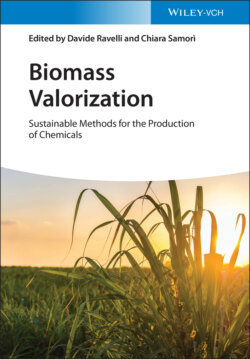Читать книгу Biomass Valorization - Группа авторов - Страница 9
Foreword
ОглавлениеWhy bother with biomass conversion? It seems so difficult compared to converting hydrocarbons into products. People used to think that we were about to run out of fossil fuels, but that was a red herring – there is enough left in the ground to serve us for hundreds of years. So, if running out of hydrocarbons is not the problem, then why are we trying to convert biomass? The problem is in the consequences of hydrocarbon usage, not in the depletion of hydrocarbons. Those consequences are severe. Fossil fuel resources are heavily contaminated with sulfur, mercury, and other pollutants. Many products from such feedstocks are persistent, leading to problems such as plastics in the oceans. However, most importantly, burning fossil‐based fuels or incinerating fossil‐based products generates carbon dioxide while the production of the feedstocks consumes no CO2.
Now, imagine a sustainable future – a future in which all of our needs are met with products made from renewable resources, and those same products are themselves recycled into new products. The feedstocks are nontoxic, the products are biodegradable, and greenhouse gas emissions are completely offset by CO2 consumption. Everyone would agree with that as a desirable goal, but we are a long way from that future. There is so much work to do before we get there. We as a society are married to our petrochemical past in so many ways, from the products we choose to make, the ways in which we make those products, and even what we teach our future chemists and chemical engineers at the universities. We need to divorce ourselves from our petrochemical past in order to bring about that sustainable future.
Make no mistake about it. That divorce is going to be messy, but it is still worth doing. At first, we thought that it would be easy. Just make existing products from biomass instead of fossil fuels. It sounds so simple, but study after study has shown that the environmental impact of transforming biomass into traditional chemical products is usually more harmful than making the same products from fossil fuels. So, what are we going to do? We have to be smarter about it. Those traditional chemical products were chosen in the past because they were easy to make from hydrocarbons. Why cannot we choose new chemical products? Let us choose chemical products that are easy to make from biomass!
Choosing new products is not the only task on our To Do list. There is a long list of tasks ahead of us. We have to
increase our knowledge of biomass conversions.
evaluate new conversion processes and products in terms of potential environmental impact, not just as an afterthought but during the design stage,
use only renewable energy in the biomass conversion processes,
develop less energetically costly ways of removing organic products from water, given that water is often the solvent for fermentations and other standard techniques for biomass transformations,
build up supply chains from producers of raw biomass, through transportation and conversion to platform chemicals, all the way to manufacture finished products,
seek new sustainable feedstocks and new platform chemicals, keeping in mind their potential availability at industrial scale and the environmental impact of using such feedstocks at scale,
design our new products so that they can be recycled efficiently, can biodegrade if discarded, and do not themselves lead to environmental crises,
change how organic chemistry is taught at the universities so that biomass feedstocks become the norm.
That sounds like a lot of work, but do not despair. There are so many talented people working on biomass conversion, such as the authors and editors of this volume, that each of these items on our “To Do” list can be achieved. The sheer variety of approaches described in the following chapters assures me that there is great hope for the future of biomass conversion. Many of you, the readers, are also developing new technologies for sustainable chemical manufacturing. We will attain that sustainable future, and this book demonstrates that we are making progress toward that goal.
My commendations to Chiara Samorì and Davide Ravelli for putting this work together, to the authors for their many contributions to the book and the field, and indeed to everyone in the green and sustainable chemistry research community for their efforts in developing the chemistry that will make sustainable living a reality.
August 2020
Philip Jessop
Queen's University
